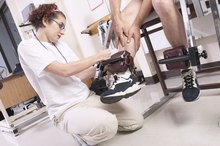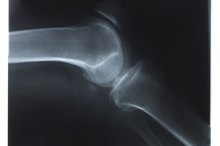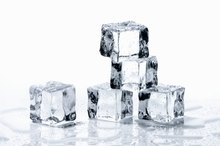Gout is one of the most painful types of arthritis. It is caused by a build-up of uric acid in your system. Sharp uric acid crystals deposit in your joints with a very common place to be the big toe. These deposits of uric acid can appear as lumps under the skin. Gout causes swelling in the joints and to help relieve the swelling, you may wonder which would be the more effective treatment: heat or ice 1.
If you are experiencing serious medical symptoms, seek emergency treatment immediately.
Ice
When tissue damage happens, the body has an automatic defense of creating heat and swelling to the area to prevent further damage. Swelling is the body's defense mechanism. There is a release of chemicals sent to the injury to create the swelling, which helps prevent movement to the area. Movement to an injured area can aggravate the injury and cause even more swelling and pain. Your body sees gout as an injury, and thus there is an automatic swelling process that happens.
Ice helps reduce swelling. It is recommended that for at least the first three to four days of the initial swelling with gout, ice is used to help reduce the inflammation and pain.
- When tissue damage happens, the body has an automatic defense of creating heat and swelling to the area to prevent further damage.
- There is a release of chemicals sent to the injury to create the swelling, which helps prevent movement to the area.
Heat
Is Ice or Heat Better for Knee Pain?
Learn More
Heat should never be used during the first 48 to 72 hours of any injury, and because gout is considered an injury to your tissues, heat should not be used in this circumstance either. Heat is a very common form of treatment for many people for their injuries. However, it is a very misused form of treatment.
After the initial treatment of cold to the affected area, putting heat on the inflicted area of gout can be relaxing and help relieve stiffness and soreness. Heat is considered a treatment to be used during what is known as the subacute and chronic stages of the injury, or gout inflammation. During these stages, heat can be very effective in decreasing pain, and promoting healing. It works by increasing circulation, easing tightened muscles, muscle spasms, and preparing your stiff joints to move more efficiently.
Heat is one of the most popular forms of home treatments for stiffness, soreness, swelling and pain. If you know when to use it, it ccan be a beneficial aid in your gout flareup. Although the effects of heat usually do not last as long as cold treatments, they can offer temporary relief for up to an hour, or possibly longer.
- Heat should never be used during the first 48 to 72 hours of any injury, and because gout is considered an injury to your tissues, heat should not be used in this circumstance either.
Related Articles
References
- Dr. Risley; Heat or Ice for Gout?
- MedicineNet; Ice or Heat --"Which Should I Apply?"
- National Institute of Arthritis and Musculoskeletal and Skin Diseases. Gout. Updated April 2016.
- Zhang Y, Chen C, Choi H, et al. Purine-rich foods intake and recurrent gout attacks. Ann Rheum Dis. 2012; 71(9):1448-53. doi:10.1136/annrheumdis-2011-201215
- Fischer E. Ueber die Harnsauer. 1 [On Uric Acid. 1]. Berichte der Deutschen Chemischen Gesellschaft. 1884: 17:328-338. doi:10.1002/cber.18980310304
- Ragab, G., Elshahaly, M., & Bardin, T. (2017). Gout: An old disease in new perspective – A review. Journal of Advanced Research, 8(5), 495–511. doi:10.1016/j.jare.2017.04.008
- Centers for Disease Control and Prevention. Gout. Updated January 28, 2019.
- Zgaga, L., Theodoratou, E., Kyle, J., Farrington, S. M., Agakov, F., Tenesa, A., … Campbell, H. (2012). The Association of Dietary Intake of Purine-Rich Vegetables, Sugar-Sweetened Beverages and Dairy with Plasma Urate, in a Cross-Sectional Study. PLoS ONE, 7(6), e38123. doi:10.1371/journal.pone.0038123
- Choi HK, Gao X, Curhan G. Vitamin C intake and the risk of gout in men: a prospective study. Arch Intern Med. 2009;169(5):502–507. doi:10.1001/archinternmed.2008.606
- Zhang Y, Neogi T, Chen C, Chaisson C, Hunter DJ, Choi HK. Cherry consumption and decreased risk of recurrent gout attacks. Arthritis Rheum. 2012;64(12):4004–4011. doi:10.1002/art.34677
- Arthritis Foundation. Gout Diet: Dos and Don’ts.
- Boban M, Modun D. Uric acid and antioxidant effects of wine. Croat Med J. 2010;51(1):16–22. doi:10.3325/cmj.2010.51.16
- Caliceti C, Calabria D, Roda A, Cicero AFG. Fructose Intake, Serum Uric Acid, and Cardiometabolic Disorders: A Critical Review. Nutrients. 2017;9(4):395. Published 2017 Apr 18. doi:10.3390/nu9040395
- U.S. Department of Health and Human Services and U.S. Department of Agriculture. 2015–2020 Dietary Guidelines for Americans. 8th Edition. Published December 2015.
- U.S. Department of Health and Human Services. Gripped by Gout. NIH News in Health. Published February 2014.
- Kakutani-Hatayama M, Kadoya M, Okazaki H, et al. Nonpharmacological Management of Gout and Hyperuricemia: Hints for Better Lifestyle. Am J Lifestyle Med. 2015;11(4):321–329. Published 2015 Sep 2. doi:10.1177/1559827615601973
Writer Bio
Maria Richmond has been a North Carolina-based freelance writer since the late 1990s. She writes children's books, fiction, non-fiction and has begun work on her autobiography. She currently writes medical articles and has had over three hundred published between the different companies she writes for.








